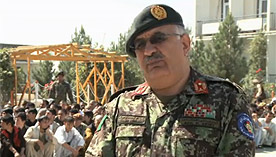ISAF and Afghan authorities counter risk of insider attacks
Protecting our forces is the primary concern of both NATO and the Afghan government. Insider attacks are a threat not just to troops serving in the International Security Assistance Force (ISAF) but also to Afghan soldiers and police as well as civilians. Steps are being taken to reduce the risk of such attacks, including improved vetting and screening, counter-intelligence and cultural awareness training.

“The enemies of Afghanistan are using insider attacks to try and undermine trust and public confidence,” explained NATO Secretary General Anders Fogh Rasmussen, speaking to the press after a meeting of NATO defence ministers on 10 October. “This will not work. We will not allow the enemy to change our strategy and undermine the trust and confidence we have built.”
“No one can drive a wedge between ISAF and our Afghan partners. We remain fully committed to supporting the Afghan security forces as we transition full security control to them by the end of 2014,” he added.
Reducing the risk
To date, the number of insider attacks in 2012 and resulting casualties have exceeded 2011 totals. Since May 2007, the Afghan National Security Forces (ANSF) have suffered almost double the amount of insider attacks that have targeted ISAF personnel.
Concerns regarding the recent increase in the number of insider attacks are shared by ISAF and the Afghan authorities, and have led them to reassess recruitment and security procedures.

General Ibrahim Ahmadzai, deputy chief of the Afghan army’s recruitment centre
“New recruits should be between 18 to 35-years-old, not addicted to drugs and should be in good health,” explains General Ibrahim Ahmadzai, deputy chief of the Afghan army’s recruitment centre. “They shouldn’t have any criminal record and they shouldn’t have been in the military before.”
As security responsibility is transitioned to the ANSF, it is the job of General Ahmadzai to make sure that motivated Afghans are recruited into the army to protect their fellow citizens, and that anyone believed to have links to insurgents is not.
“Our intelligence department works on every new recruit, checking where they are living, if they have any connection with al-Qaida and other enemies of the country,” says General Ahmadzai. “Those people who are linked to the enemies of this country, they will not be selected for the Afghan National Army.”
Implementing new measures
This is one of many measures being taken to reduce the risk of insider attacks. Others include: cultural awareness training; embedding several hundred Afghan counter-infiltration staff with the ANSF and in training schools to monitor behaviour of Afghan service members; specific close-quarter combat and active shooter training for personnel at increased risk of an insider attack; and the ANSF outlawing the sale of uniforms and establishing an anonymous reporting system for personnel, as well as ensuring that soldiers and police get adequate leave and regular pay, and that all weapons are accounted for properly.
Afghan leaders have also conducted investigations into past events in an effort to identify and implement lessons learned.
The Alliance is constantly refining the approach to reduce insider attacks. All of these initiatives, along with many others, will help the many ISAF and ANSF personnel, who work side-by-side each day, do their jobs with less risk of an insider attack.
